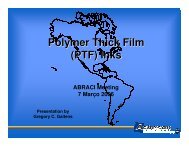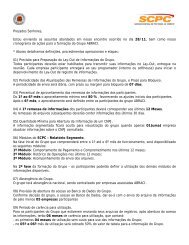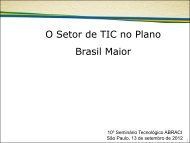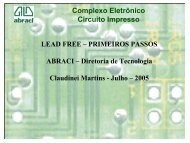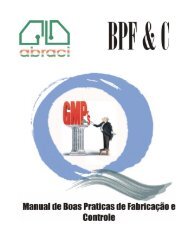BOAS PRÃTICAS DE FABRICAÃÃO E CONTROLE - ABRACI ...
BOAS PRÃTICAS DE FABRICAÃÃO E CONTROLE - ABRACI ...
BOAS PRÃTICAS DE FABRICAÃÃO E CONTROLE - ABRACI ...
You also want an ePaper? Increase the reach of your titles
YUMPU automatically turns print PDFs into web optimized ePapers that Google loves.
The illustrations in this document portray specific points<br />
noted in the title of each page. A brief description<br />
follows each illustration. It is not the intent of this<br />
document to exclude any acceptable procedure for<br />
component placement or for applying flux and solder<br />
used to make the electrical connection; however, the<br />
methods used must produce completed solder joints<br />
conforming to the acceptability requirements described<br />
in this document.<br />
In the case of a discrepancy, the description or<br />
written criteria always takes precedence over the<br />
illustrations.<br />
1.3 Specialized Designs<br />
IPC-A-610, as an industry consensus document, cannot<br />
address all of the possible components and product<br />
design combinations. However, the standard does<br />
provide criteria for commonly used technologies. Where<br />
uncommon or specialized components or technologies<br />
are necessary, good judgment should be used while<br />
applying the criteria of this standard. However, where<br />
similar characteristics exist, this document may provide<br />
guidance for product acceptance criteria. Often, unique<br />
definition is necessary to consider the specialized<br />
characteristics while considering product performance<br />
criteria. The development should include customer<br />
involvement or consent and the criteria should include<br />
agreed definition of product acceptance.<br />
Whenever possible this criteria should be submitted to<br />
the IPC Technical Committee to be considered for<br />
inclusion in upcoming revisions of this standard.<br />
1.4 Terms & Definitions<br />
Items noted with an * are quoted from IPC-T-50, ‘‘Terms<br />
and Definitions for Interconnecting and Packaging<br />
Electronic Circuits.’’<br />
1.4.1 Classification<br />
Criteria defined in this document reflect three classes,<br />
which are as follows:<br />
Class 1 — General Electronic Products<br />
Includes consumer products, some computer and<br />
computer peripherals suitable for applications where<br />
cosmetic imperfections are not important and the major<br />
requirement is function of the completed electronic<br />
assembly.<br />
Class 2 — Dedicated Service Electronic Products<br />
Includes communications equipment, sophisticated<br />
business<br />
machines, and instruments where high performance<br />
and extended life is required and for which<br />
uninterrupted service is desired but not critical. Certain<br />
cosmetic imperfections are allowed.<br />
Class 3 — High Performance Electronic Products<br />
Includes the equipment and products where continued<br />
performance or performance-on-demand is critical.<br />
Equipment downtime cannot be tolerated and must<br />
function when required, such as in life support items or<br />
flight control systems. Assemblies in this class are<br />
suitable for applications where high levels of assurance<br />
are required, service is essential, or the end-use<br />
environment may be uncommonly harsh.<br />
1.4.2 The customer has the ultimate responsibility<br />
for identifying the class to which his assembly is<br />
evaluated.<br />
Thus, accept and/or reject decisions must be based on<br />
applicable documentation such as contracts, drawings,<br />
specifications, standards and reference documents.<br />
1.4.3 Acceptance Criteria<br />
When IPC-A-610 is cited or required by contract as a<br />
standalone document for inspection and/or acceptance,<br />
the requirements of ANSI/J-STD-001 ‘‘Requirements for<br />
Soldered Electrical and Electronic Assemblies’’ do not<br />
apply (unless separately and specifically required).<br />
In the event of conflict, the following order of recedence<br />
applies:<br />
1. Procurement as agreed and documented between<br />
customer and vendor.<br />
2. Master drawing or master assembly drawing eflecting<br />
the customers detailed requirements.<br />
3. When invoked by the customer or per contractual<br />
agreement, IPC-A-610.<br />
4. Other documents to extent specified by the ustomer.<br />
The user (customer) has the responsibility to specify<br />
acceptance criteria. If no criteria is specified, required,<br />
or cited, then best manufacturing practice applies.<br />
When J-STD-001 and IPC-A-610 or other related<br />
documents are cited, the order of precedence is to be<br />
defined in the procurement documents.<br />
Criteria are given for each class in four levels of<br />
acceptance: Target Condition, Acceptable Condition,<br />
and either Defect Condition or Process Indicator<br />
Condition.



